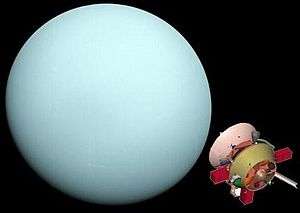NASA Uranus orbiter and probe

A Uranus orbiter and probe is a mission proposal for study of the planet Uranus. It was recommended to NASA in 2011 by its Planetary Science Decadal Survey 2013–2022.[1] A mission study was conducted which also considered a Neptune orbiter,[2] however, for feasibility reasons Neptune was dropped in favor of Uranus. Two white papers on Uranus exploration were also submitted to the Decadal Survey.[3][4] The survey listed the Uranus orbiter and probe as the third priority for a Flagship mission class after the MAX-C rover and the JEO component of the Europa Jupiter System Mission.
Although a chemical propulsion mission to Uranus is possible, solar electric propulsion (ion engine) is preferred because it allows a larger spacecraft mass. If funded, the proposed mission would launch in 2020–2023 with launch-windows of 21 days every year; travel time to Uranus with solar-electric propulsion would be 13 years, with one Earth flyby for gravity assist.[2]
In early 2012, because of the FY2013 budget proposal, NASA Flagship-class planetary missions were put on hold.[5] There is also a study that recommended a medium-class concept for the New Frontiers program to develop such an orbiter for Uranus.[3][5]
See also
- Planetary Science Decadal Survey
- Uranus Pathfinder
- Argo (spacecraft) (another Outer planet spacecraft proposal from the 2010s)
- New Horizons 2
- Neptune Orbiter
References
- ↑ Vision and Voyages for Planetary Science in the Decade 2013–2022
- 1 2 Uranus and Neptune Orbiter and Probe Concept Studies, Ice Giants Decadal Study
- 1 2 THE CASE FOR A URANUS ORBITER, Mark Hofstadter et al.
- ↑ THE ATMOSPHERES OF THE ICE GIANTS, URANUS AND NEPTUNE, Mark Hofstadter et al.
- 1 2 "NASA shelves ambitious — and expensive — flagship missions"
